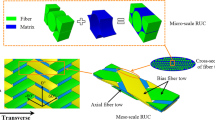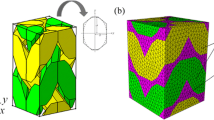Abstract
Based on continuum damage mechanics (CDM), a sophisticated 3D meso-scale finite element (FE) model is proposed to characterize the progressive damage behavior of 2D Triaxial Braided Composites (2DTBC) with 60° braiding angle under quasi-static tensile load. The modified Von Mises strength criterion and 3D Hashin failure criterion are used to predict the damage initiation of the pure matrix and fiber tows. A combining interface damage and friction constitutive model is applied to predict the interface damage behavior. Murakami-Ohno stiffness degradation scheme is employed to predict the damage evolution process of each constituent. Coupling with the ordinary and translational symmetry boundary conditions, the tensile elastic response including tensile strength and failure strain of 2DTBC are in good agreement with the available experiment data. The numerical results show that the main failure modes of the composites under axial tensile load are pure matrix cracking, fiber and matrix tension failure in bias fiber tows, matrix tension failure in axial fiber tows and interface debonding; the main failure modes of the composites subjected to transverse tensile load are free-edge effect, matrix tension failure in bias fiber tows and interface debonding.









Similar content being viewed by others
References
Yang, L., Li, Z., Sun, T.: Effects of gear-shape fibre on the transverse mechanical properties of unidirectional composites: virtual material design by computational micromechanics. Appl. Compos. Mater. 1–14 (2017). doi:10.1007/s10443-016-9580-6
Han, G., Guan, Z., Li, Z.: Microscopic progressive damage simulation and scale-span analysis of cross-ply laminate based on the elastic–plastic theory. Appl. Compos. Mater. 22(1), 1–12 (2015)
Ren, Y., Jiang, H., Ji, W.: Improvement of progressive damage model to predicting crashworthy composite corrugated plate. Appl. Compos. Mater. 1–22 (2017). doi:10.1007/s10443-017-9610-z
Guo, S., Li, D., Zhang, X.: Buckling and post-buckling of a composite C-section with cutout and flange reinforcement. Compos. Part B. 60(60), 119–124 (2014)
Liu, P.F., Yang, Y.H., Gu, Z.P.: Finite element analysis of progressive failure and strain localization of carbon fiber/epoxy composite laminates by ABAQUS. Appl. Compos. Mater. 22(6), 711–731 (2015)
Li, D.S., Li, J.L., Chen, L.: Finite element analysis of mechanical properties of 3D four-directional rectangular braided composites part 1: microgeometry and 3D finite element model. Appl. Compos. Mater. 17(4), 373–387 (2010)
Li, D.S., Fang, D.N., Lu, Z.X.: Finite element analysis of mechanical properties of 3D four-directional rectangular braided composites—part 2: validation of the 3D finite element model. Appl. Compos. Mater. 17(4), 389–404 (2010)
Xu, L., Jin, C.Z., Ha, S.K.: Ultimate strength prediction of braided textile composites using a multi-scale approach. J. Compos. Mater. 49(4), 477–494 (2014)
Wang, C., Zhong, Y., Adaikalaraj, P.F.B.: Strength prediction for bi-axial braided composites by a multi-scale modeling approach. J. Mater. Sci. 51(12), 6002–6018 (2016)
Miravete Bielsa, J.M.: 3D mesomechanical analysis of three-axial braided composite materials. Compos. Sci. Technol. 66(15), 2954–2964 (2006)
Ivanov, D.S., Baudry, F., Broucke, B.V.D.: Failure analysis of triaxial braided composite. Compos. Sci. Technol. 69(9), 1372–1380 (2009)
Binienda, W.K., Li, X.A.: Mesomechanical model for numerical study of two dimensional Triaxially braided composite. J. Eng. Mech. 136(11), 1366–1379 (2010)
Zhong, S., Guo, L., Liu, G.: A continuum damage model for three-dimensional woven composites and finite element implementation. Compos. Struct. 128, 1–9 (2015)
Lu, Z., Xia, B., Yang, Z.: Investigation on the tensile properties of three-dimensional full five-directional braided composites. Comput. Mater. Sci. 77(3), 445–455 (2013)
Wang, B., Fang, G., Liang, J.: Failure locus of 3D four-directional braided composites under biaxial loading. Appl. Compos. Mater. 19(3), 529–544 (2012)
Zako, M., Uetsuji, Y., Kurashiki, T.: Finite element analysis of damaged woven fabric composite materials. Compos. Sci. Technol. 63(3), 507–516 (2003)
Zhang, D., Waas, A.M., Yen, C.F.: Progressive damage and failure response of hybrid 3D textile composites subjected to flexural loading, part I: experimental studies. Int. J. Solids Struct.. s 75–76, 309–320 (2015)
Zhang, D., Waas, A.M., Yen, C.F.: Progressive damage and failure response of hybrid 3D textile composites subjected to flexural loading, part II: mechanics based multiscale computational modeling of progressive damage and failure. Int. J. Solids Struct.. s 75–76, 321–335 (2015)
Fang, G.D., Liang, J., Wang, B.L.: Progressive damage and nonlinear analysis of 3D four-directional braided composites under unidirectional tension. Compos. Struct. 89(1), 126–133 (2009)
Zhang, C., Xu, X.: Finite element analysis of 3D braided composites based on three unit-cells models. Compos. Struct. 98(3), 130–142 (2013)
Zhang, C., Mao, C., Zhou, Y.: Meso-scale damage simulation of 3D braided composites under quasi-static axial tension. Appl. Compos. Mater. 1–21 (2017). doi:10.1007/s10443-016-9579-z
Xiao, X., Kia, H.G., Gong, X.J.: Strength prediction of a triaxially braided composite. Compos. A: Appl. Sci. Manuf. 42(8), 1000–1006 (2011)
Littell, J.D., Binienda, W.K., Arnold, W.A.: Effect of microscopic damage events on static and ballistic impact strength of triaxial braid composites. Compos A Appl. Sci. Manuf. 40(12), 1846–1862 (2009)
García-Carpintero, A., Herráez, M., Xu, J.: A multi material Shell model for the mechanical analysis of Triaxial braided composites. Appl. Compos. Mater. 1–21 (2017). doi:10.1007/s10443-017-9593-9
Zhang, C., Li, N., Wang, W.: Progressive damage simulation of triaxially braided composite using a 3D meso-scale finite element model. Compos. Struct. 125, 104–116 (2015)
Zhang, C., Binienda, W.K., Goldberg, R.K.: Meso-scale failure modeling of single layer triaxial braided composite using finite element method. Compos. A: Appl. Sci. Manuf. 58(58), 36–46 (2014)
Zhang, C., Binienda, W.K.: Numerical analysis of free-edge effect on size-influenced mechanical properties of single-layer Triaxially braided composites. Appl. Compos. Mater. 21(6), 841–859 (2014)
Hashin, Z.: Failure criteria for unidirectional fiber composites. J. Appl. Mech. 47(2), 329–334 (1980)
Murakami, S.: Mechanical modeling of material damage. ASME J Appl. Mech. 55, 280–286 (1988)
Dassault Systemes: Abaqus 6.13Documentation (2013)
Benzeggagh, M.L., Kenane, M.: Measurement of mixed-mode delamination fracture toughness of unidirectional glass/epoxy composites with mixed-mode bending apparatus. Compos. Sci. Technol. 56(4), 439–449 (1996)
Alfano, G., Sacco, E.: Combining interface damage and friction in a cohesive-zone model. Int. J. Numer. Methods Eng. 68(5), 542–582 (2010)
Littell, J., Justin, D.: Measurement of epoxy resin tension, compression, and shear stress–strain curves over a wide range of strain rates using small test specimens. J. Aerosp. Eng. 21(3), 162–173 (2008)
Zhang, C., Binienda, W.K., Kohlman, L.W.: Analytical model and numerical analysis on the elastic behavior of Triaxial braided composites. J. Aerosp. Eng. 27(3), 473–483 (2014)
Alfano, G., Crisfield, M.A.: Finite element interface models for the delamination analysis of laminated composites: mechanical and computational issues. Int. J. Numer. Methods Eng. 50(7), 1701–1736 (2001)
Alfano, G.: On the influence of the shape of the interface law on the application of cohesive-zone models. Compos. Sci. Technol. 66(6), 723–730 (2006)
Kohlman, L.W.: Evaluation of test methods for triaxial braid composites and the development of a large multiaxial test frame for validation using braided tube specimens. The University of Akron; (2012)
Acknowledgements
This research is co-supported by the National Natural Science Foundation of China (No. 11402011) and the Fundamental Research Funds for the Central Universities (No. 201401390741).
Author information
Authors and Affiliations
Corresponding author
Rights and permissions
About this article
Cite this article
Ren, Y., Zhang, S., Jiang, H. et al. Meso-Scale Progressive Damage Behavior Characterization of Triaxial Braided Composites under Quasi-Static Tensile Load. Appl Compos Mater 25, 335–352 (2018). https://doi.org/10.1007/s10443-017-9623-7
Received:
Accepted:
Published:
Issue Date:
DOI: https://doi.org/10.1007/s10443-017-9623-7




